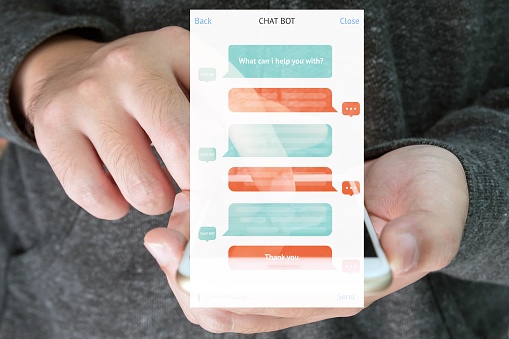Chatbots are a relatively new marketing technology, and a hot trend for 2018. Like many new waves in the marketing world, you should familiarize yourself with the advantages and disadvantages before jumping in.
As of March 28th, Facebook Messenger is putting a pause on new bots, due to the FTC’s investigation of Facebook’s data practices. So you won’t be able to get your new chatbot working on FB for a few weeks yet, and there are new limitations. In the meantime, if you’re considering using chatbots, take the time to learn what they can do for you, and what they can’t.
What are chatbots?
If you’ve ever been on a website and a chat box opens up with a prompt asking if you have any questions, you might have texted with a customer service person, or it might have been a chatbot. Chatbots are computer programs that simulated conversations in messaging systems like Facebook Messenger, kik, Slack, or a company website. They’re basically apps for messengers.
Chatbots are often used for customer service, but can also be an interactive F.A.Q., guide customers through purchase decisions, or place orders. There are also third-party chatbots that can call a car service for you, or find a hotel.
Chatbots may use machine learning to improve over time or audio recognition, but many are simpler than that. You don’t need to learn how to program an artificial intelligence to develop a successful chatbot.
Why use chatbots?
The numbers don’t lie – people love using text messages and prefer it over other forms of communication in some instances. In 2015, messenger app use surpassed all other social networks. If that’s where the customers are, then you want to be there.
Chatbots can also free up time and resources, since a chatbot can be available 24/7 and maintain many conversations at once. Automation may free up customer service time, if the quality of the chatbot is as good as a person. Imagine that your customer never has to wait for a response from you!
There is also a robust chatbot ecosystem right now, which makes it easy to jump on the bandwagon. There are plenty of third-party bots, distribution channels, and enabling tech companies that make it easy to develop a chatbot.
At the same time, chatbots are not a marketing strategy panacea, and there is potential for things to go very wrong. If your customer service chatbot is worse and less convenient than talking with a person, then you could lose your customers to a frustrating experience. If you’re going to do it, you have to do it well. Additionally, chatbots are not effective in all spheres.
When Chatbots are Effective, and When They’re Not
While perception of chatbots is becoming more positive, 56% of people globally would prefer to speak to a human, according to this liveperson survey. Most people believe that a person will understand what they need better than a chatbot, and unless the chatbot is well designed, that’s definitely going to be the case. But in the case that a chatbot is just as effective as a person, 55% of people would prefer to talk to a chatbot.
Customer service is definitely going to be a future home for chatbots. People want quick and easy answers at their fingertips, and a clear channel of communication. If the chatbot cannot answer a person’s question, then it should be designed to put them in touch with a person who can.
Chatbots are not going to be very useful at the top of the purchase funnel. First of all, no one wants to be advertised to in their messages. Spamming people in their messages is going to drive people away from your company, and the messaging system as a whole. Thankfully, right now a person needs to agree to receive texts from a chatbot before it can send a message. The people who will engage with your chatbot are most likely already your customers, so the chatbot should be designed to retain customers and encourage them to make more purchases.
One very successful chatbot that is not strictly customer service is the chatbot GWYN of 1-800-FLOWERS. GWYN helps people pick flowers for their occasion by following prompts. After deploying GWYN, the company saw a %6.3 revenue increase in the first quarter, and gained new customers through the chatbot. The service makes it so easy to figure out what flowers to get, and that’s how GWYN found “her” success.
Mya is a chatbot that used to belong to First Jobs, a company that helped recent graduates find job placements. Mya walked candidates through the job search and application process. Mya was so successful that First Job is now Mya Systems Inc., and sells Mya to recruiters to optimize their process.
According to this study, 27% of people would buy a simple item via chatbot. There is some purchase potential with chatbots, as in the case of GWYN. For a brief time Starbucks had a chatbot for ordering coffee called My Starbucks Barista, but it has since been discontinued and mobile ordering is regulated in the Starbucks app.
The most successful chatbots will fill a need, not just be another attempt at getting customers’ attention. If you are not improving your customers experience with a chatbot, then don’t bother investing the time and money in it.

